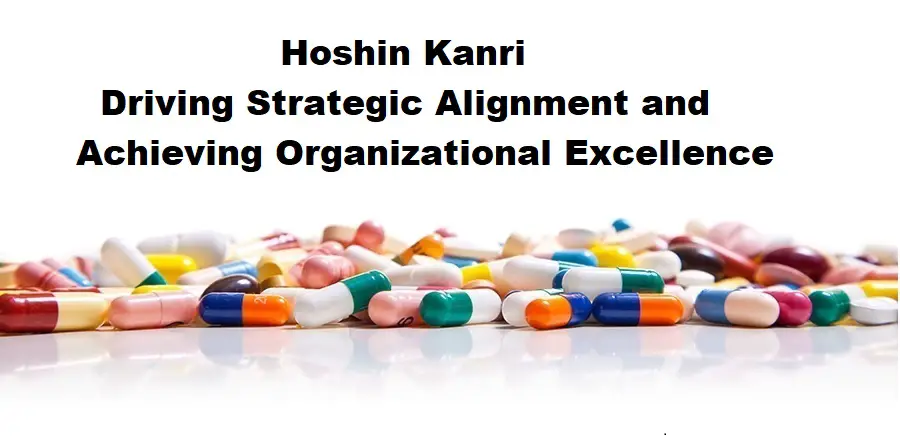Hoshin Kanri: Driving Strategic Alignment and Achieving Organizational Excellence
In today’s dynamic and competitive business environment, organizations face the challenge of effectively translating strategic goals into actionable plans and achieving organizational excellence. Hoshin Kanri, a powerful strategic management methodology originating from Japan, provides a structured approach to aligning strategic objectives, deploying them throughout the organization, and driving continuous improvement. By implementing Hoshin Kanri, organizations can foster a culture of goal-oriented collaboration, enhance decision-making processes, and achieve sustainable business success. In this blog post, we will explore the concept of Hoshin Kanri, its principles, strategies for implementation, and practical applications across various industries.
Understanding Hoshin Kanri : Definition and Origins:
Definition of Hoshin Kanri: Explain Hoshin Kanri as a strategic management process that aligns organizational goals, cascades them throughout the organization, and ensures ongoing performance measurement and improvement.
Origins of Hoshin Kanri: Discuss the historical context of Hoshin Kanri, its development in post-World War II Japan, and its integration into Lean management principles.
Principles of Hoshin Kanri:
Policy Deployment: Highlight the key principle of Hoshin Kanri, which is the deployment of strategic objectives throughout the organization to ensure alignment and focus.
Catchball: Discuss the collaborative nature of Hoshin Kanri, emphasizing the importance of iterative communication and feedback loops to refine and align strategic goals.

Benefits of Hoshin Kanri:
Strategic Alignment: Explore how Hoshin Kanri ensures strategic goals are aligned across all levels of the organization, enabling cohesive efforts and resource allocation.
Continuous Improvement Culture: Highlight how Hoshin Kanri fosters a culture of continuous improvement by providing a framework for monitoring progress, identifying gaps, and making necessary adjustments.
Strategies for Implementing Hoshin Kanri
Establishing Strategic Direction:
Vision and Mission: Discuss the importance of clearly defining the organization’s vision and mission, which serve as the foundation for setting strategic goals in Hoshin Kanri.
Setting Breakthrough Objectives: Explore the process of setting breakthrough objectives, which are ambitious and impactful goals that drive the organization forward.
Cascading Strategic Goals:
Hoshin Planning: Explain the Hoshin Planning process, which involves cascading strategic goals from the top-level to lower-level departments or teams, ensuring alignment and clarity.
Policy Deployment Matrix: Discuss the use of a policy deployment matrix to visually represent the cascading of goals, responsibilities, and performance measures throughout the organization.
Strategy Execution and Monitoring:
X-Matrix: Explain the X-Matrix, a visual tool used in Hoshin Kanri to align strategic objectives, action plans, targets, and key performance indicators (KPIs).
Performance Measurement: Discuss the importance of defining relevant KPIs, tracking progress, and reviewing performance against strategic objectives to ensure accountability and drive improvement.
III. Practical Applications of Hoshin Kanri
Manufacturing Industry:
Lean Manufacturing: Discuss how Hoshin Kanri is integrated into Lean manufacturing practices, aligning strategic objectives with Lean principles and driving continuous improvement in production processes.
Quality Management: Explore how Hoshin Kanri can be applied in quality management systems, ensuring strategic alignment in achieving quality goals and driving organizational excellence.
Service Industry:
Service Excellence: Explain how Hoshin Kanri can be adapted to service-oriented industries, such as healthcare, hospitality, or customer service, to align strategic objectives with service quality, customer satisfaction, and operational efficiency.
Process Improvement: Highlight the application of Hoshin Kanri in service process improvement, enabling organizations to set goals, track progress, and drive continuous improvement in service delivery.
Project Management:
Strategic Project Alignment: Discuss how Hoshin Kanri can be used in project management to ensure alignment between project goals and strategic objectives, enabling efficient resource allocation and driving project success.
Agile Project Management: Explore the integration of Hoshin Kanri with Agile methodologies, such as Scrum or Kanban, to align iterative project goals with strategic objectives and foster continuous improvement.
Overcoming Challenges and Ensuring Sustainable Implementation
Leadership Support:
Leadership Role in Hoshin Kanri: Emphasize the importance of leadership support in driving Hoshin Kanri implementation, providing resources, setting expectations, and leading by example.
Creating a Strategic Focus: Discuss the significance of leaders actively engaging in the Hoshin Kanri process, ensuring strategic alignment, and fostering a culture of goal-oriented collaboration.
Employee Engagement and Empowerment:
Communicating the Strategic Vision: Highlight the need for effective communication to ensure employees understand the organization’s strategic direction and their roles in achieving it.
Empowering Employees: Discuss the importance of empowering employees to contribute their expertise, insights, and ideas in the Hoshin Kanri process, fostering ownership and engagement.
Continuous Improvement and Adaptation:
Regular Review and Evaluation: Emphasize the need for periodic review and evaluation of the Hoshin Kanri process, identifying gaps, and making necessary adjustments to ensure ongoing alignment and improvement.
Agile Approach: Discuss the adoption of an agile mindset in Hoshin Kanri implementation, enabling organizations to adapt to changing market conditions, seize opportunities, and drive innovation.
Conclusion
Hoshin Kanri provides organizations with a structured and systematic approach to strategic management, enabling them to align goals, deploy them throughout the organization, and drive continuous improvement. The principles and strategies discussed in this blog post demonstrate the significance of Hoshin Kanri in various industries, including manufacturing, services, and project management. Overcoming challenges and ensuring sustainable implementation require leadership support, employee engagement, and a commitment to continuous improvement. By embracing Hoshin Kanri, organizations can foster strategic alignment, enhance decision-making processes, and achieve organizational excellence in today’s dynamic business landscape.

